ETF Trading
John Carls
Last Update 3 年前
Leveraged ETF product is a kind of financial derivative that is very popular in the traditional financial market. It is a trading product that achieves a certain multiple (such as 3 times) of the target daily asset return rate under the premise of a given underlying asset (such as BTC). If the BTC price rises 1%, the net value of the corresponding triple leveraged ETF will rise 3%; The net value of a negative 3 times product would fall by negative 3 percent.
Leveraged ETFs are perpetual products, with no expiration date and prices that do not go to zero. Therefore, there is no risk of a blowout. Investors can buy or sell in the secondary market at any time and do not need to pay any margin to achieve the purpose of trading leverage.
Fixed bar tokens are denominated in USDT and are traded in an "Exchange Trade" mechanism. In essence, leveraged ETF corresponds to the unit share of a fixed leveraged fund. The fund manager ensures that the fund returns a fixed target multiple of the asset income anchored by the asset income. Investors can obtain a specified multiple of the underlying asset income by trading ETF product shares. When the underlying asset moves in the opposite direction beyond a set threshold. Through the introduction of the rebalancing mechanism, the fund management side of the fund position readjustment ensures that the net loss of the fund will not exceed a certain limit.
In short, through the risk control measures of the fund manager, ETF investors can avoid the fear of exposure and obtain a certain leverage multiple of the return of the underlying asset.
Currently, each token supports 3X "Market rally" (3X Long) and 3x "Market decline" (3x Short). You can see the complete list of leveraged ETFs on ZKE's official website - The trading - ETF page.
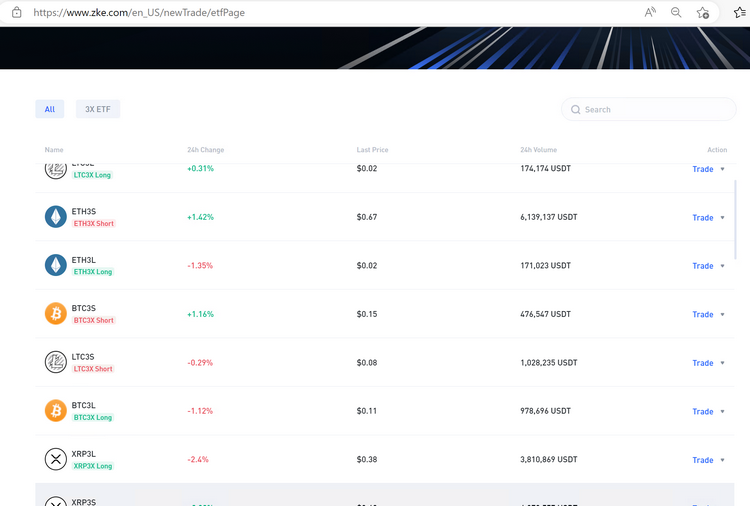
Trading ETFs on PC
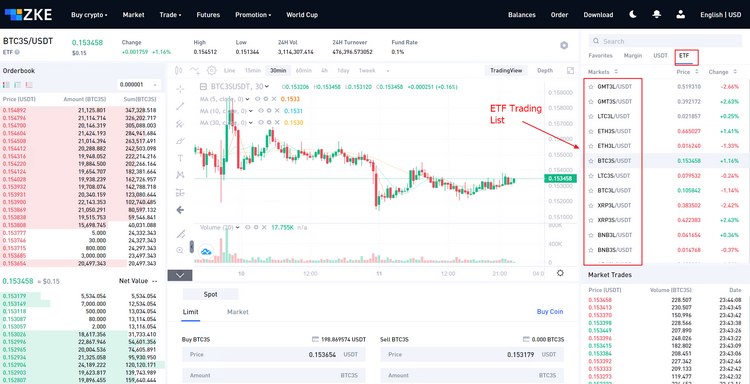

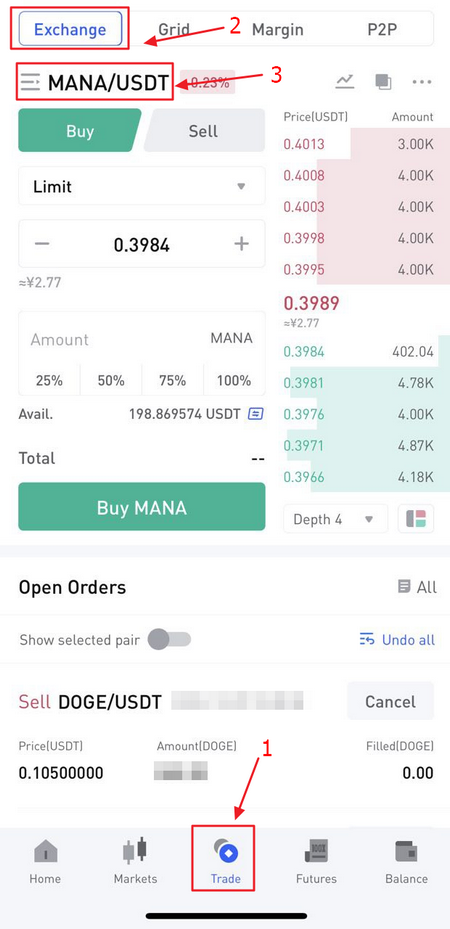
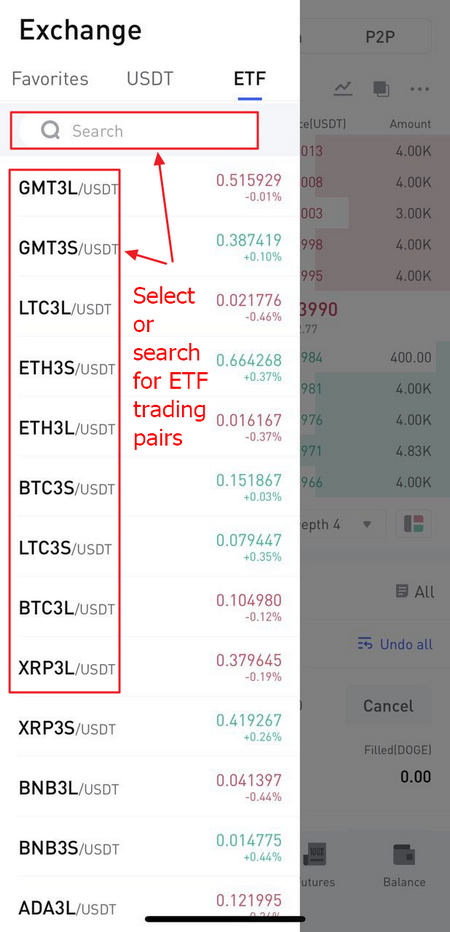
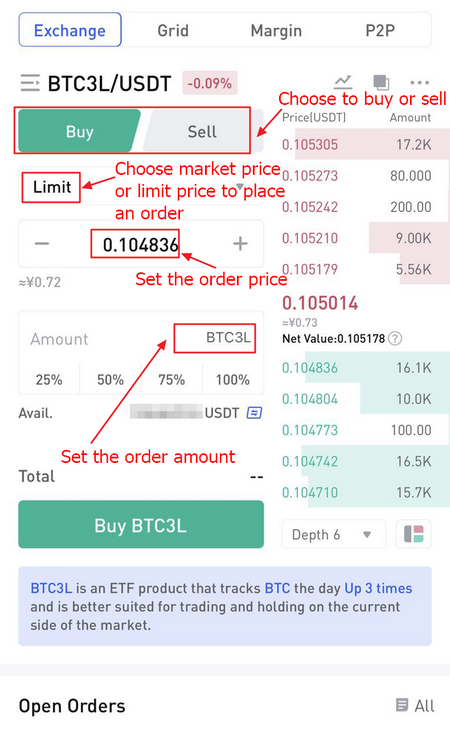
Here's why leveraged ETFs are worth watching:
First, spot trading, no bond
Users can buy leveraged ETFs on this platform just like ordinary spot products so that users can avoid problems such as margin and strong equity risk. Take 3 times long BTC (BTC 3L) as an example, the user only needs to look at the price and net value -- input the purchased quantity -- choose to buy BTC 3L, without any other operations.
Second, the compound interest effect, risk control
The leveraged ETF will automatically transfer the profit from the position into the principal, that is, if the leveraged ETF purchased by the user generates surplus float (surplus float before rebalancing), then the surplus will increase the position of the leveraged ETF in the next rebalancing, that is, the new position is 3 times the surplus float so that the return will form a compound interest pattern.
At the same time, leveraged ETFs have built-in risk control mechanisms (see the Rebalancing Mechanisms section for details). For example, if a user is 3x long BTC and BTC falls by 33%, then the user's position will no doubt be forced out, leaving him with nothing. However, if the user buys BTC 3L, the leveraged ETF will adjust its position according to the market decline through a rebalancing mechanism to avoid the liquidation of the user's position. Even if the price of BTC falls by 33%, the user's position still has assets remaining.
The essence of leveraged ETF is to ensure that ETF holders enjoy a fixed target multiple of the underlying asset's daily returns by fixing the returns of leveraged funds. The fixed leverage Fund is managed by the Platform or a fund manager approved by the Platform. ZKE platform publishes the net value of the fund in real-time to maintain a high degree of transparency.
In theory, the net value of the fund is the fair trading price of ETF shares in the secondary market. But because of continued market volatility, the net value of the fund is the fair trading price of ETF shares in the secondary market. However, due to the continued volatility of the market, there may be a deviation from the fair price (net value of the fund) in the secondary market at some time, resulting in a certain premium.
When the premium exists, there will be arbitrage opportunities. Arbitrageurs in the secondary market can gradually eliminate the premium through arbitrage operations to ensure that the trading price of the token follows the fair price. Ordinary users, should pay attention to their order price do not deviate too much from the net value, otherwise, they will suffer great losses. At the same time, when the net price is lower than a certain threshold (0.1U at the initial stage), the platform will merge the varieties (the net price will become 10 times that before the merger, but the corresponding quantity will also become 1/10 of that before the merger, and the total assets of users will not be affected in any way) to improve the sensitivity of price changes and optimize the trading experience of users.
Take one day as a period (UTC16:00 to the next day UTC16:00), and the final moment of the k period is denoted as t,k = 0,1,2,.... to is equal to 0. Let the initial net value of the unit fund be 100USDT, that is, S(0) = 100USDT
. S(0): initial value of the fund;
. S(t): the net value of the fund at time t, t > 0;
. P(0): the price of the underlying asset at the initial moment;
. P(t): the price of the underlying asset at time t:
. M: Target leverage multiple, we can choose 2, 3, -1, -2, -3
The return rate of the fund and the underlying asset in the k period are respectively
R,(k) = S(t) - S(t-1)Rp(k) = P(t) - P(t-1)S(tk-1)P(tk-1)
The goal of a fixed leveraged fund is to make its return rate of each period M times the return rate of the underlying asset, namely R,(k) = M x B,(k), k = 1,2.
A fixed-leverage fund is essentially an actively managed fund that anchors its return over each cycle to M times the return on the underlying asset. Fund positions at the beginning of each cycle must adjust as the price of the underlying asset changes to ensure this is achieved. Position adjustment is mainly based on the net value of the fund at the beginning of each cycle to adjust the position so that the risk of this cycle is open and anchored M times the risk exposure of the corresponding underlying asset. If the net value at the beginning of the period is S(tk), the exposure set at the beginning of the period is an equivalent USDT position of M * S(tk).
The ZKE platform normally rebalances positions at 00:00:00 each day (UTC+8) to ensure that the combined leverage ratio does not deviate too much from the agreed ratio. When the market fluctuates violently, if the fluctuation range of the underlying asset exceeds the given threshold compared with the previous equilibrium point (at the beginning, we set the threshold to 15% for 3 times long and short, but in the future, the threshold may be different for other multiple products), we will also carry out temporary rebalancing to control the risk of the portfolio. The temporary rebalancing is only for those who lose money because of the volatility. That is, if the BTC rises to 15%, we will rebalance the -3 leveraged ETF and make no adjustments to the other products. Note that if the market trend continues after the "untimed rebalancing" is triggered, then the user's losses will be smaller, but if the market trend reverses immediately after the trigger, the speed of the product's rebound will also be reduced by the rebalancing reduction.
As mentioned earlier, daily leveraged ETFs reinvest any profits they make. If there is a loss, sell part of the position to achieve 3 times leverage, to avoid forced liquidation risk.
Take the "long product" that is three times positive for BTC as an example. If the daily trend of BTC is +10%, +10%, +10%, +10%, +10%, then the 4-day return of this product is 185%, which is three times higher than the 4-day spot return of 46%. If BTC's daily moves are -10%, -10%, -10%, -10%, then the 4-day loss of the product is 76%, which is less than three times the 4-day spot loss of 35%. If BTC moves +10%, -10%, +10%, -10% daily, then the 4-day yield of the product is -17%, which is three times worse than the 4-day spot yield of -2%.
Therefore, when the time spans a rebalancing cycle, leveraged ETFs cannot guarantee that the multi-day cumulative return and spot return maintain fixed multiple relationships. Generally speaking, under the trend, the performance of the leveraged ETF will be better than the declared leverage multiple (that is, the cumulative increase of the ETF in the same direction will be more than 3 times the underlying return, while the decline of the ETF in the opposite direction will be less than 3 times of the underlying return), while the performance of the leveraged ETF in the volatile market will be worse than the declared leverage multiple.
Leveraged ETF trading pairs are spot trading, trading fees are as follows:
The transaction fee for trading leveraged ETF products on this platform is 0.2%(the specific fee is based on the user level, please go to the background to check). Meanwhile, we will charge a certain management fee for each time of leverage every day to pay the capital rate generated by the fund portfolio (generally 0.001%, we will adjust it according to market fluctuations later. The specific management fee of each subject can be found in the corresponding transaction page), transaction fees and other necessary fees. The management fee will be reflected in the change in net value, that is, it will be presented as' less the value of the corresponding leveraged ETF 'and will only be charged at 0:00 Singapore time. There will be no fee if the product is not held at that time.
Due to the adjustment mechanism of leveraged ETF, the most applicable market conditions are unilateral market (or trend market), in which the performance and advantages of leveraged ETF will be very obvious; But leveraged ETFs can cause more wear and tear in a market with big swings on both sides, such as big gains followed by big declines.
Therefore, to reduce risk exposure, we should first make a correct judgment on the market price trend, and then pay attention to whether the direction of market fluctuations is unilateral.
Declaration:
Leveraged ETF is an emerging financial derivative, the above content does not constitute investment advice, please pay attention to risk control.
Leveraged ETFs greatly reduce the risk of strong liquidation, but there is a risk of approaching zero and liquidation in extreme market conditions. Please pay attention to the difference between net value and price to avoid losses.

